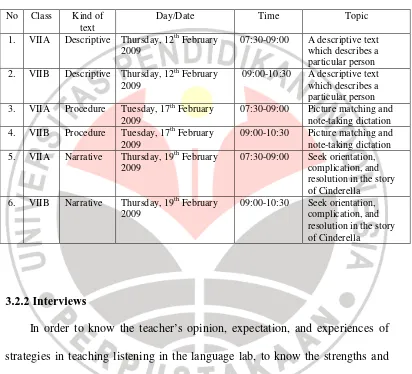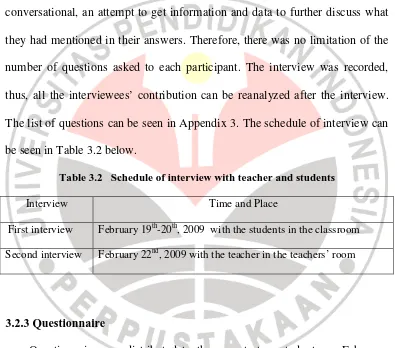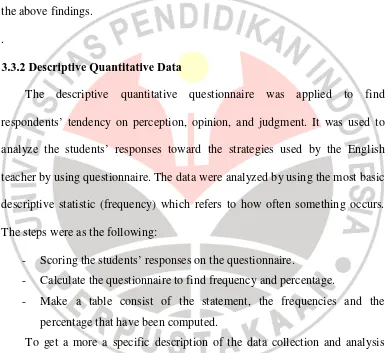CHAPTER III
RESEARCH METHODOLOGY
This chapter describes methodological aspects of the present study which attempts to find information about teacher’s strategies in teaching listening in the language laboratory, their strengths and weaknesses, and the students’ responses toward teacher’s strategies. Three main aspects of the study are discussed: first, research design; second, data collection method; and third, data analysis method.
This study uses both qualitative and descriptive quantitative design by employing a case study. Three instruments of data collection methods: observation, interview, questionnaire, and supported by document analysis as the data collection techniques.
3.1 Research Design
item of view is essential; therefore, the objective of qualitative research is to understand participants from their items of view (McMillan, 1989).
Furthermore, Merriam (1988:16) mentions that “A qualitative data consists of detailed description situations, events, people, attitudes, believes and thoughts; excerpts or entire passages from documents, correspondence, records and case histories”. This study can be considered as in case study because it posseses the characteristics of a case study among others.
The case of this study is to do with the people suh as an English teacher and seventy-two students as reseach participants. In line with this, Merriam (1998) mentions that “a case study presents that the case, then, could be person such as a teacher, a student, a principles, a program, and so on. The analysis of the finding was aimed at presenting how the teacher implemented strategies in teaching listening in the language laboratory, their strengths and weaknesess, and the students’ responses toward the teacher’s strategies.
The other characteristics of a case study are it can be conducted in small scale (Merriam, 1988; Nunan, 1992; Connole et. al., 1993). A case study which is in line with this study is it used a variety of lines of action in its gathering segments and can meaningfully make up and contribute to the application of theory (Yin, 2003 as cited in Berg, 2007). Hence, this study employed multiple data collection techniques, namely observation, interview, questionnaire, and document analysis.
teacher. Hence, this study employed three instruments of data collection methods; observation, interview, questionnaire, and supported by document analysis.
3.1.1 Setting of the Study
The study was conducted in a junior high school in Tanjung Pinang Kota Kepulauan Riau Province. It is a National Standard School which recently has become one of the most favorite junior high schools there. It has five classes for grade VII which consist of one bilingual class and four regular classes with 180 students, it equipped with a language laboratory that consists of 38 booths equipped with CCTV, headset, computer, microphone, tape recorder, TV, internet, VCD/DVD player, LCD, and just one English teacher who teaches them and they study listening skill in the language laboratory.
The access for the study became the reason why this study conducted in this school because the English teacher as participant is my fellow teacher in the group of course teachers (MGMP) in Kepulauan Riau Province. The teacher as the subject ever taught at the same school with the researcher for three years in a junior high school in Lingga Regency Kepulauan Riau Province
3.1.2 Subjects of the Study
The subjects of this study include one English teacher who teaches grade VII students and seventy-two students of junior high school in Tanjung Pinang Kota. They voluntary participated in this study. The teacher was chosen beacuse there was one English teacher who teaches at grade VII and automatically she became the subject. She has taught English almost ten years and has experiences in teaching and learning in the language laboratory so that she can give valuable information relates to this study.
Generally, grade VII students of junior high school age 11 until 14 years old. They may be categorized as young learners. It likes Slattery and Willis (2005:54) state that: “young learners (YL) were 7-12 years old; very young learners (VYL) were defined is under 7 years of age.” Harmer (2001:38) supports the idea with his statement as follow “young children, especially those up the age of nine or ten, learn different from older children, adolescent and adult.”
Furthermore, this study chose seventy-two students at grade VII as the subjects comprising thirty six students of bilingual class and thirty six students of regular class. They were taken to represent the five classes of grade VII In teaching science, mathematics, and Indonesian in the bilingual class almost 50% of teachers use English, 90% use English in the language laboratory, and they visit foreign tourist resorts to practice their English every month, but the regular classes do not. They function as the subjects of this study for the purpose of obtaining data and information needed to find out the students’ responses toward the strategies used by the English teacher. Besides that, this way was intended to know the situation of students in the class observation.
3.2 Instruments for Data Collection
In collecting data, this study used the appropriate instruments such as Observation, interview, questionnaire, and supported by document analysis which provided extremely rich, detailed, and in-depth information. All data collection was recorded in order to keep the authenticity of the data.
3.2.1 Class Observation
says “observation notes focused on what was said and done by both the teacher and students in the interactional setting” as cited in (Emilia, 2008).
The intensive classroom observation was conducted three times for each class in the first week until the second week of February 2009. During classroom observation, the observer sat among the students observing teacher’s activities and taking notes on the steps taken by teacher; teacher’s strategies and teacher’s skills in conducting teaching-learning process.
The purpose of this way was to investigate how far the teacher implemented strategies in teaching listening in the language lab, the strengths and weaknesses, and the students’ responses toward teacher’s strategies. The observer did not take part in the classroom activity or acted non-participant observer.
The class was observed carefully until the observer enable to identify the pattern of teacher’s strategies in teaching listening in the language laboratory, the strengths and weaknesses, and students’ responses toward the strategies used by the English teacher. During the classroom observation the observer paid attention to the teacher’s presentation, methods, strategies, and teacher or students interaction in conducting the classroom activities.
accurate data. The videotaping records all of activities, specifically during teaching and learning activities in the language lab. The research schedule arranged as drawn in Table 3.1 below.
Table 3.1 Research schedule for class activities No Class Kind of
text
Day/Date Time Topic
1. VIIA Descriptive Thursday, 12th February 2009
07:30-09:00 A descriptive text which describes a particular person 2. VIIB Descriptive Thursday, 12th February
issue Kvale (1996) says “the data from interview were then transcribed, categorized, and interpreted to address the research questions”.
3.2.2.1Teacher Interview
Regarding with the function of interview which was used to gather the data and information, the interview to an English teacher was relevant to answer the research questions number 1, 2, and 3 that is to investigate how far the teacher implements strategies in teaching listening in the language laboratory, their strengths and weaknesses, and the students’ responses toward teacher’s strategies.
The interview was carried out after the class ended with the questions in Bahasa Indonesia and this study prepared the list of questions which can be seen in Appendix 2. The interview was in the form of semi-structured that lasted for 35 minutes and it was initiated with open ended question. The questions were then followed by subsequent questions, which were conversational, in an attempt to get the interviewee to further discuss what she has mentioned in her answers. The interview was also recorded. Thus, the interviewee’s contribution can be recoreded and reanalyzed after the interview.
3.2.2.2 Students Interview
6 to 8 minutes for each student. It was carried out in Bahasa Indonesia to the thirty students who consist of fifteen students of bilingual class and fifteen students of regular class. Each class was classified into three groups; five students from the high proficiency, five from middle, five from low ones. The questions were followed by subsequent questions, which were conversational, an attempt to get information and data to further discuss what they had mentioned in their answers. Therefore, there was no limitation of the number of questions asked to each participant. The interview was recorded, thus, all the interviewees’ contribution can be reanalyzed after the interview. The list of questions can be seen in Appendix 3. The schedule of interview can be seen in Table 3.2 below.
Table 3.2 Schedule of interview with teacher and students
Interview Time and Place
First interview February 19th-20th, 2009 with the students in the classroom Second interview February 22nd, 2009 with the teacher in the teachers’ room
3.2.3 Questionnaire
(1992:143) mentions that “A closed item is one in which the range of possible responses in determined by the researcher, for example: foreign language should be compulsory in high school: Agree/neutral/disagree.”
According to Arikunto (1996) there are six aspects of questionnaire guideline; (1) learning material input, (2) listening activities, (3) listening goals, (4) listening competencies, (5) listening difficulties, and (6) problem-solving strategies. The study used Likert scale questionnaire to check the students’ responses toward teacher’s strategies with five alternative responses; strongly agree, agree, undecided, disagree, strongly disagree as Gall, Gall & Borg (2003:214) state that “ A Likert scale asks individuals to check their level of agreement (e.g. strongly agree, agree, undecided, disagree, or strongly agree).”
The questionnaire was written in Bahasa Indonesia to ensure complete understanding of items by participants. The questionnaire guide was presented in Appendix 4.
3.2.4 Documents Analysis
In line with the instruments to collect data above, triangulation took place in this study. The triangulation has function to validate data Wiersma (1986) as cited in Sugiyono (2008) mentions that “triangulation is qualitative cross-validation. It assesses the sufficiency of the data that relates to the convergence of multiple data sources or multiple data collection procedures”.
3.3 Data Analysis
The data of this study were analyzed through qualitative and descriptive quantitative data analysis. The data analysis was immediately conducted after the data from observation, interview, questionnaire, and from document were available. All data were analyzed on basis of the research questions stated in chapter one, and were categorized into three main central themes: the teacher’s strategies, the strengths and weaknesses, and the students’ responses toward the strategies used by the English teacher in teaching listening in the language laboratory. There were two techniques in analyzing the data.
3.3.1 Qualitative Data
To support the answer of the research question number 1, document analysis was also conducted. The documentation, which covered students’ text, was useful to gain data about the students’ knowledge of developing skills in learning listening. Furthermore, teacher’s lesson plans, teaching listening materials, and students’ achievement were also taken to be analyzed to support the above findings.
.
3.3.2 Descriptive Quantitative Data
The descriptive quantitative questionnaire was applied to find respondents’ tendency on perception, opinion, and judgment. It was used to analyze the students’ responses toward the strategies used by the English teacher by using questionnaire. The data were analyzed by using the most basic descriptive statistic (frequency) which refers to how often something occurs. The steps were as the following:
- Scoring the students’ responses on the questionnaire.
- Calculate the questionnaire to find frequency and percentage.
- Make a table consist of the statement, the frequencies and the percentage that have been computed.
To get a more a specific description of the data collection and analysis techniques above are described in the tabulation below.
Table 3.3 Data collection and analysis techniques
the English teacher use employed both qualitative and desriptive quantitative design by employing a case study. The setting of the study was a junior high school in Tanjung Pinang Kota and it involved an English teacher and seventy-two students grade VII as the participants.


